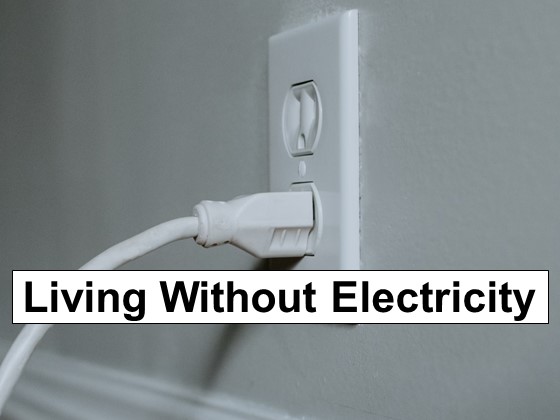I’m really beginning to appreciate just how easy modern society makes life. Although I spend a lot of time and resources preparing myself, I really don’t want to live without necessities, like water and electricity, unless I had no other choice. These folks, however, choose to do so. And if you want to know how they do it, watch this very informative video because it could be exactly what you need when times get tough…

Living Without Electricity
Posted in
by
Discover the 5 Minute Survival Blueprint course and get yourself prepared fast, easy, and inexpensively! It’s my gift from one prepper to another. 🙂
Comments
4 responses to “Living Without Electricity”
-
I commend this presenter for providing a detailed list of the living categories that may involve electricity e.g. cooking, lighting, heating etc. However, this video falsely describes the presenter as living “without electricity.” The presenter uses a 1000 W power station with AC outputs. She also uses rechargeable solar lights and headlamps. Additionally, the presenter uses someone else’s ON GRID electricity to (a) make the ice she buys, and (b) power the Wi-Fi and Laundromat that she uses Thus, the presenter lives neither OFF THE GRID, nor WITHOUT ELECTRICITY.
-
I agree, she uses alternative forms of electricity that works for short periods of power outages.
-
That’s a fair point. And I’d suggest it goes to show just how crucial power is to our lives, even in seemingly small ways.
-
I agree, I think the article was misnamed, it should be Living Without MAINS Electricity! the laundry situation can be fixed using a rubber sink plunger head attached to a broom handle and a large plastic rubbish bin, half fill with water hot or cold depending on the soap/detergent being used (we used liquid detergent and fabric softener so it didn’t leave soap stains in woolens) and using the plunger as the agitator churned the load for 10-15 minutes, then emptied and refilled with clean rinse water once or twice to wash the soap suds out then hung out on a line to dry, a bit of an effort but no electricity needed. For lighting, we mostly used kerosene hurricane lanterns and occasionally used a tin can candle lamp which was enough to see your way to the (outside) loo at night if it wasn’t too windy, the only problem with the kero lanterns is that at night when carrying one you need to shade your eyes from the flame otherwise it reduces your night sight which is where a candle in a tin with “shutters” cut into the side which lets the light out in one direction while still providing some wind protection for the candle works. It would be hard to eliminate electricity entirely although for small communication devices phones, tablets etc. you could possibly create your own primary battery e.g. using a bank of cells with copper and aluminium
with vinegar as the electrolite you’ll need about 10 for usb voltage. Just my 2 cents worth!
-
Leave a Reply